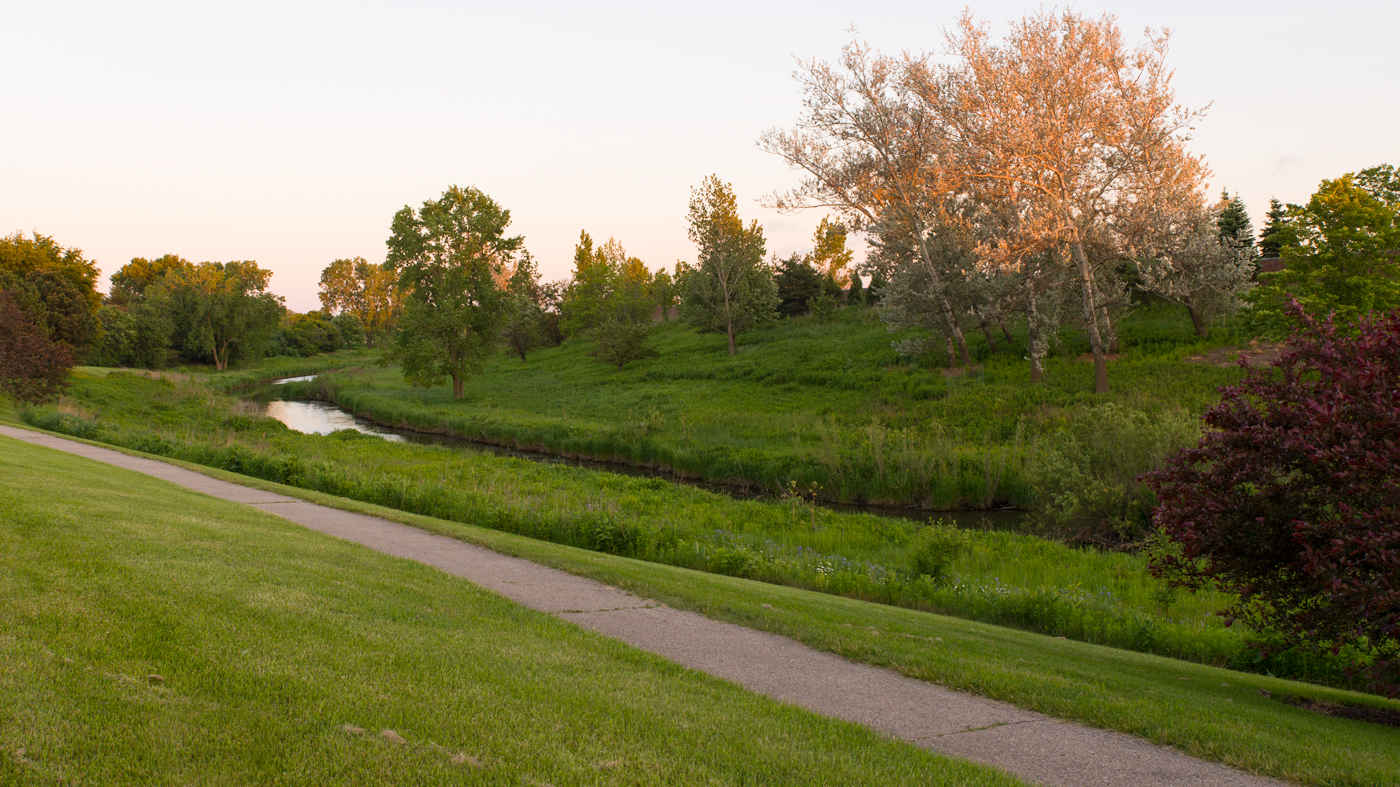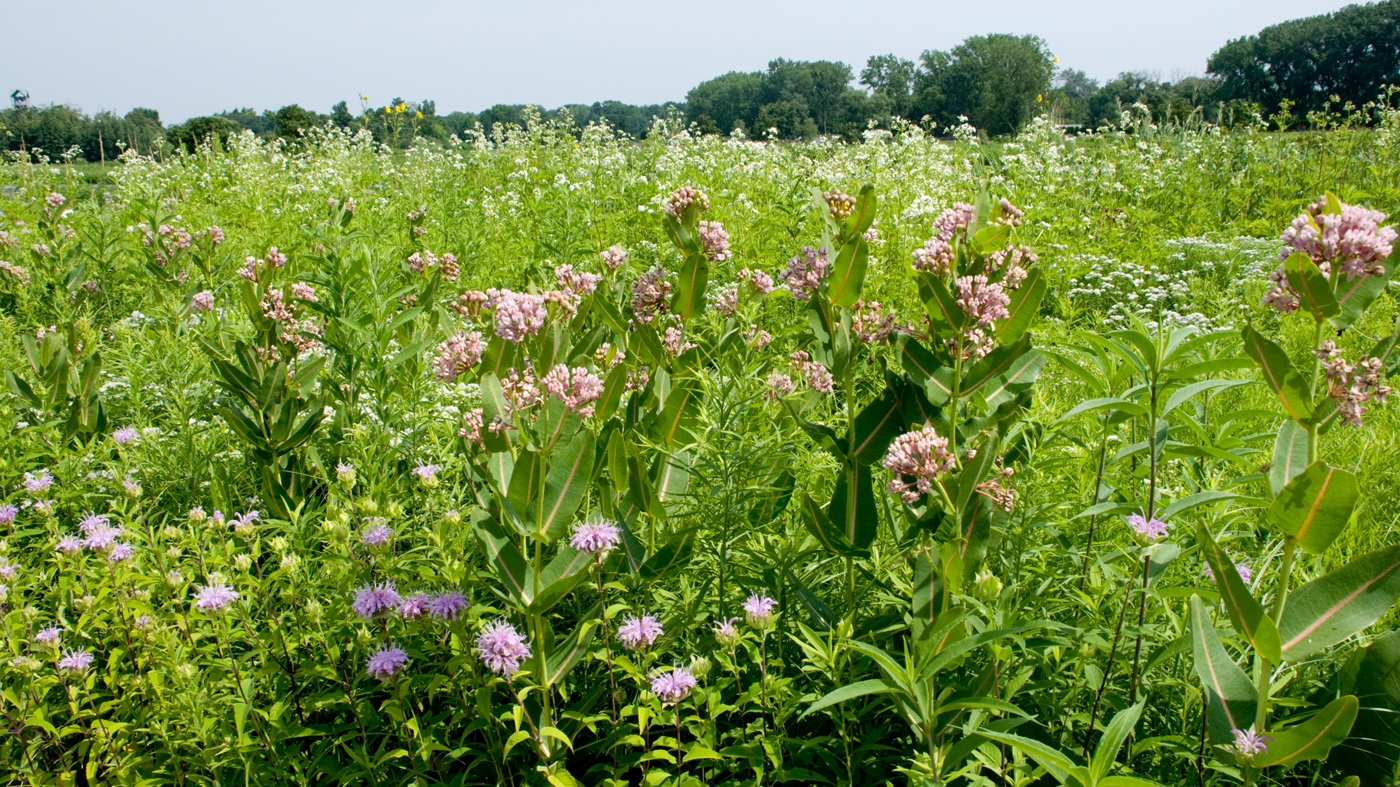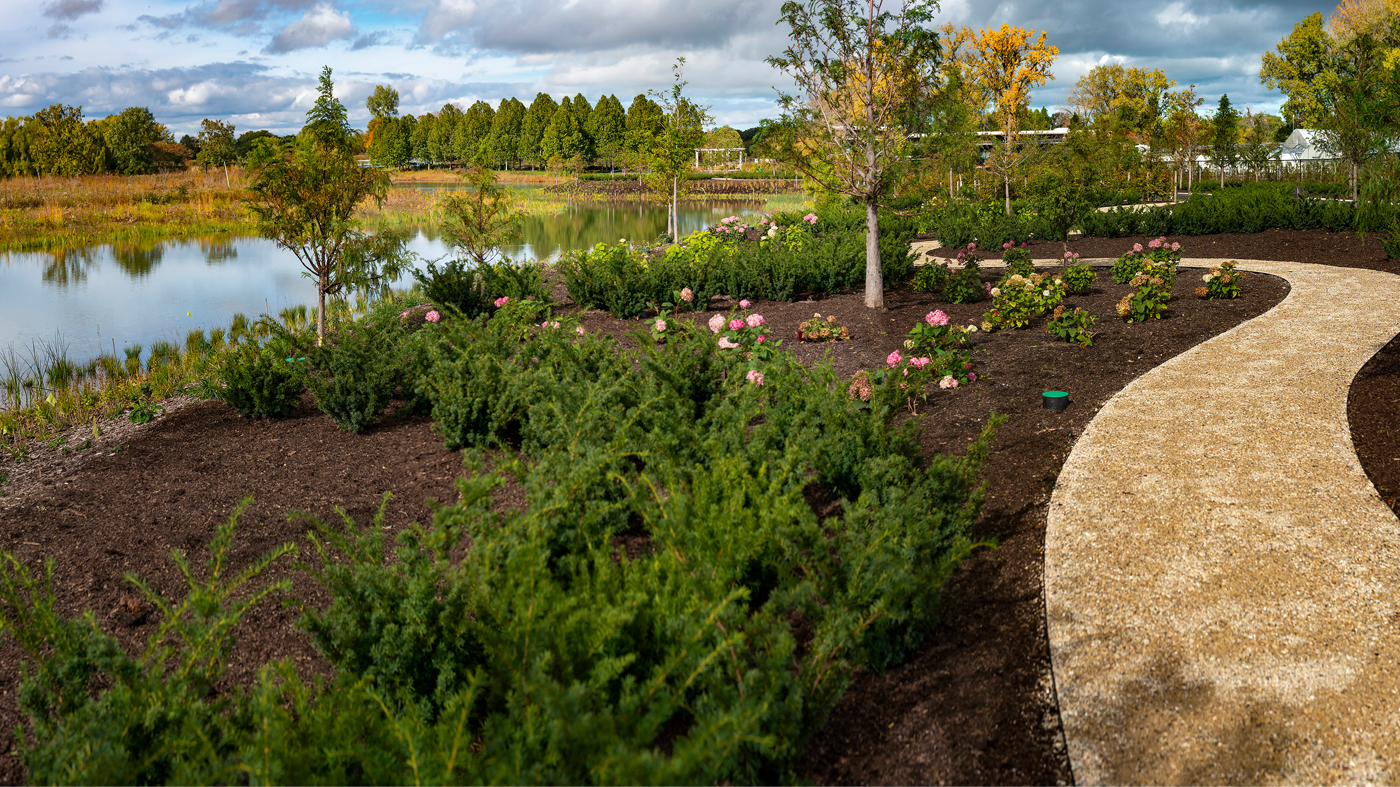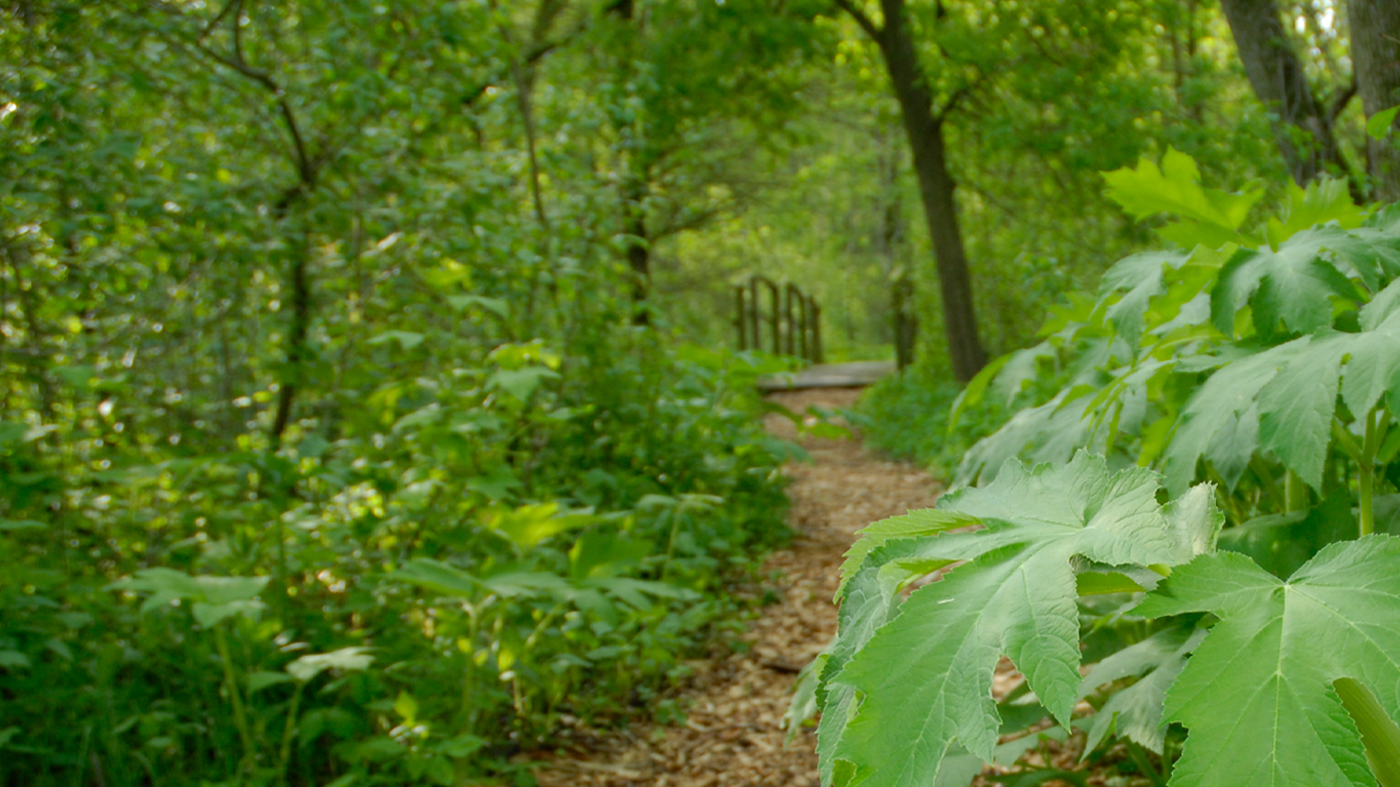

A Summer Perimeter Walk
Welcome to high summer at the Chicago Botanic Garden, where color, scent, and the play of light on water await you at nearly every turn. A perfect way to experience the lush abundance of the season is with a walk around the Garden’s 2.6-mile perimeter. Whether enjoying panoramic scenes or individual blooms, visitors find themselves captivated by nature as they take this walk. It’s an excellent way to gain a perspective of the Garden’s 385 acres of gardens set amid islands and lakes, bordered by native midwestern woodlands, a prairie, and a river.
So put on your walking shoes, and let’s begin!
A good place to start is on the north end of the Garden by the Learning Campus, conveniently located near parking lots 5 and 6. On any summer day you’ll very likely see children at Camp CBG, along with their counselors, busy exploring or, at midday, resting in the shade. Nearby is a service road with a gate that bars all but official Garden vehicles; follow this road as it curves, becoming the Garden’s westernmost road. Glance at your handy Garden map (available on the free GardenGuide smartphone app, or a paper map at the Visitor Center), and you’ll see that you are gradually heading southward.


Along the Skokie River Corridor
This first part of your Garden walk leads you past a variety of trees, planted on a grassy landscape that rolls gently eastward toward the Garden’s main lakes and westward to the Skokie River Corridor. Among the many trees you’ll pass — many of them labeled — are Scots pines; sugar, Autumn Blaze, and Jade Glen Norway maples; Winter King and downy hawthorns; Tartarian dogwoods; Tristis weeping willows; and Danada Charm, Szechuan, Bergmann, David, and Gaussen elms.
The Skokie River valley is a continuing experiment in how to use low-impact, natural methods to improve water quality, restore floodplains, and increase the diversity of insect, animal, bird, and plant life. The river meanders for a mile along the base of an abundantly planted slope that rises to meet the Garden wall. Beautiful as well as practical, the wall borders the highway and along with the grassy berm, absorbs much of the vehicular noise from the other side. On this summer day as on most, the sound of traffic is a subdued hum underneath an interior chorus of birds singing, insects buzzing, and leaves rustling in the breeze.
In addition to the Skokie River, lakes and the waterways linking them are a prominent feature of the Garden. There are 60 acres of lakes, containing 150 million gallons of water on average, and they reach a depth of 18 feet.
Keep walking, and across the North Lake you’ll see the Regenstein Fruit & Vegetable Garden, with its ripening fruit trees and bountiful vegetable beds. Next, the Aquatic Garden comes into view, with its winding boardwalk overlooking dazzling waterlilies and lotuses. Nearby is the Bulb Garden, where a wide variety of bulbs are strategically planted to ensure a constant color show from early spring well into fall. During this midsummer walk, the Bulb Garden is abloom with pineapple and trumpet lilies, along with ornamental onions and summer hyacinth.

More Gardens Along the Way
At this point, if you’d like, you can step across a bridge to see these and other gardens up close; in fact, the Circle Garden, with its ever-changing displays of seasonal annual plants, is just steps away. Linger here if you must, but then retrace your steps over the bridge and continue along the perimeter walk past Spider Island, with its lovely sweeps of woodland, meadow, and shoreline plants, and its dignified birches and alders.
Strolling southward, the waterway widens and we now see, to our east, the Gardens of the Great Basin. Connected by scenic pathways and distinctive bridges, the Gardens of the Great Basic include the Water Gardens, Lakeside Gardens, and majestic Evening Island, where the Theodore Butz Memorial Carillon is a focal point. Along the water, mass succession plantings of aquatic and semi-aquatic native plants, perennials, ornamental grasses, irises, and roses guarantee a color show throughout all seasons. These plants were chosen for their ease of management and their adaptability to shoreline challenges and water fluctuations. Here is another chance to cross over the water to visit the gardens up close; foregoing that option and continuing the perimeter walk, however, we find ourselves at the entrance to the Garden’s 15-acre Dixon Prairie.

A Pause at the Prairie
Six different types of prairie are represented at the Dixon Prairie: fen, gravel hill, mesic, sand, savanna, and wet. Most obvious during our perimeter walk is the mesic prairie, often found on flat or gently rolling plains, with rich, dark, moist but well-drained soil. By mid-July this prairie is awash in greens, yellows, and whites, with occasional splashes of purple. Many of the plants—big bluestem, compass plant, prairie milkweed, wild bergamot, false sunflower, and Joe-Pye weed, for example — are 3 to 5 feet tall by midsummer. If you need to rest, a pleasant stop is at the bench between two bur oaks, next to the south lake fed by the Skokie River. A red-winged blackbird alights, bobbing, on a false sunflower near the shore. Canada geese have gathered to rest on a mud flat in the middle, while Caspian terns flutter above, folding their wings and plummeting to catch fish in the shallow waters below.
Shade, Sun, and Science
Take a last, lingering look at the prairie, then cross to the Garden’s eastern road, following it north past a grove of thick white poplars (if we turned south, we’d eventually leave the Garden and find ourselves on Dundee Road). We draw near the William Pullman Plant Evaluation Garden and step inside for a quick tour. In the cooling shade there, a variety of plants create a living canvas of greens, among them hostas, ferns, cranesbill, coral bells, and ligularia. Astilbes add bright pinks and purples to the portrait. Emerging into the sun again, we come upon the All-America Selection Garden, this season featuring bewitching Black Magic Rose shrubby geraniums, Margarita Rosita moss roses, and Can Can Scarlet carnations.

The Garden’s East Road also features a much-loved and well-used bike path. Amid the company of walkers, joggers, and bikers we soon we reach the Daniel F. and Ada L. Rice Plant Conservation Science Center, a spectacular building where, from the soaring space of the main lobby, scientists may be seen working in their labs. This building was awarded a Gold LEED rating by the U.S. Green Building Council. Surrounding the Plant Science Center is the Rainwater Glen, where horticulturists evaluate plants specially selected and grown to handle rainwater runoff and filter impurities from the water. Atop the center is an innovative Green Roof Garden, which — like the center itself — is open to the public. Tempting though it is to linger in this wondrous place, we forge ahead on the final phase of our perimeter walk.
Across the road from the Plant Science Center is the Trellis Bridge. This bridge makes it easier for Garden visitors to enjoy the entire Garden and underscores the vital connection between beautiful gardens and plant conservation research. At the base of the bridge in circular form, then curving gently northward to follow the lakeshore, is the Bernice E. Lavin Plant Evaluation Garden — also home to the Garden’s perennial plant breeding program. This evaluation garden contains a wide variety of sun-loving plants, from asters and other perennial flowers to shrub roses, grasses, and evergreens.
Just beyond this point, across the water, the Elizabeth Hubert Malott Japanese Garden is a serene presence at the Garden. Also known as Sansho-En, or Garden of Three Islands, visitors may be seen strolling on two of them, but a third — Island of Everlasting Happiness — is not open to visitors; it is designed for contemplation from a distance.

Along the Oak Woodland
Continuing along, we come to a rustic pavilion announcing the entrance to the McDonald Woods nature trail. This hundred-acre oak woodland, on the east side of the road, is one of four natural areas in the Garden (the other three are the prairie, lakes, and Skokie River Corridor) and is part of a longstanding, ongoing, and successful conservation effort. McDonald Woods contains not only red, swamp, and white oak trees, but flowers like trillium, asters, and tall thistles. Downy woodpeckers and white-breasted nuthatches are among the birds that make their homes here.
You’re almost done! To complete your walk, you can go straight at the gate into the parking lots (you’ll have to cross several before you end up where you began, in lots 5 and 6) OR take a right at the gate — this is the end of the Garden’s East Road — and continue along the road leading toward the Garden’s main entrance on Lake Cook Road. As you walk this final, brief stretch along the painted bike path, be aware that cars leaving the Garden drive along this road. It’s worth the work of keeping an eye on the lookout for cars, however, because it gives you more time to enjoy McDonald Woods (if you have time, the shaded interior paths are a treat).
Time to give those walking shoes a rest!
When your perimeter walk ends, you can head for your car—but first, consider a refreshing drink at the Garden View Café, where you can relax on the deck overlooking the water. Recall the many plants you saw on your journey; perhaps you have been inspired to include some of them in your own landscape. Reflect on the abundance of the day, and plan your next visit to the Chicago Botanic Garden. Did we mention how gorgeous the perimeter walk is during fall, winter, and spring?

